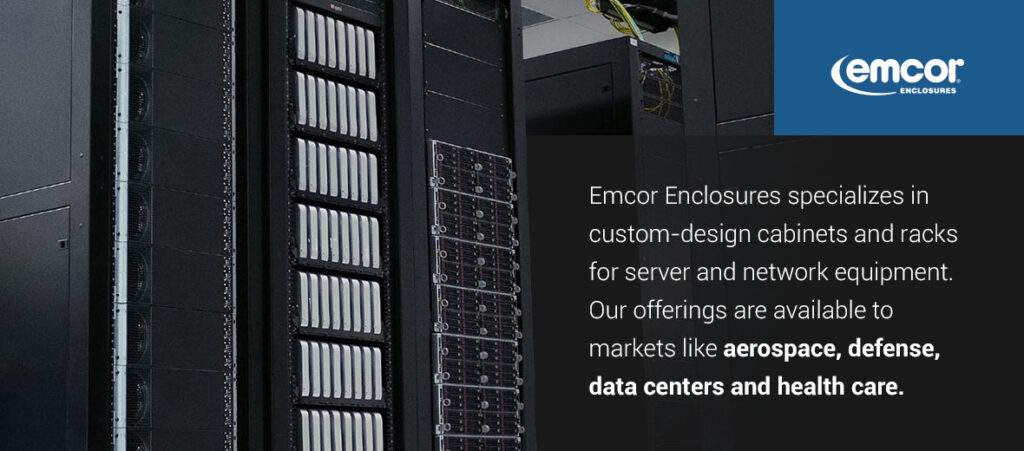History and Applications of MIL-STD-461

The MIL-STD-461 standard has evolved over the years. Although initially developed for electromagnetic applications in the United States military, several commercial industries have adopted the framework to improve device performance and reliability. MIL-STD-461 reduces noise in electronic devices working closely, enhancing interoperability, efficiency and safety. Manufacturers working on military and other contracts must comply with these requirements to ensure operational success.
Today, we’ll discuss MIL-STD-461, considering its history and applications. You’ll also learn why ruggedized computer systems testing is essential and how Emcor Enclosures can help.
What Is MIL-STD-461?
MIL-STD-461 is a U.S. military standard that establishes the requirements for equipment’s electromagnetic compatibility (EMC). It specifies the limits and test methods to ensure the electronic device operates efficiently within the intended electromagnetic environment without causing electromagnetic interference (EMI) to other equipment. EMI consists of undesired signals called noise, especially when the device operates in close proximity. This phenomenon can cause a decline in performance or a complete shutdown. Keeping the EMI under control is, therefore, critical in military applications.
The standard covers various aspects, such as:
- Radiated emissions: This relates to the unintentional electromagnetic emissions generated by electronic devices.
- Conducted emissions: This involves the noise components generated by subcircuits or devices and transferred to other subcircuits or devices through power planes, cabling or parasitic capacitance.
- Conducted susceptibility: This measures how well electronic equipment withstand EMI transmitted through signal or power lines.
- Radiated susceptibility: This is similar to conducted susceptibility but relates to radiated signals instead of cables.
The Department of Defense (DoD) requires MIL-STD-461 compliance in most contracts, but some civilians adopt the standard due to its benefits. Adhering to the standard ensures the reliable and safe operation of military devices in challenging electromagnetic conditions.
The Origin of MIL-STD-461
Before MIL-STD-461, various military agencies had separate standards for EMC. This resulted in a lack of uniformity and interoperability, which meant most devices had to be redesigned before being used. The solution was to adopt a standardized approach to serve all government and military agencies.
The DoD enacted a broad defense radio frequency compatibility program in 1960, later renamed the Electromagnetic Compatibility Program. It directed military services and research and development initiatives toward developing communication devices with built-in EMC. In 1966, three military departments developed a joint standard to reduce interference throughout DoD technologies, consolidating the separate requirements.
The outcome was the publication of MIL-STD-461, MIL-STD-462 and MIL-STD-463. The intention was to create a tri-service EMI specification. While MIL-STD-461 focused on the EMI requirements, MIL-STD-462 prescribed measurement methodology. MIL-STD-463 contained the definitions and acronyms. MIL-STD-464 was later introduced to tackle systems and platforms at large.
MIL-STD-462 has undergone several revisions, namely:
- MIL-STD-461A in 1968
- MIL-STD-461B in 1980
- MIL-STD-461C in 1986
- MIL-STD-461D in 1993
- MIL-STD-461E in 1999
- MIL-STD-461F in 2007
- MIL-STD-461G in 2015
Although the standard was initially developed for military applications, it has been adopted in commercial operations.
Applications of MIL-STD-461
MIL-STD-461 has various applications, enhancing the EMC of electronic devices used by the military. Here are some examples:
- Aerospace and defense: The standard is relevant in the aerospace engineering industry, where electronic systems must operate reliably in challenging electromagnetic conditions.
- Naval vessels: Communication systems, radar equipment and power electronics on naval vessels must comply with MIL-STD-461.
- Submarines: MIL-STD-461 compliance can help prevent disruptions in the onboard electronics in submarines.
- Ground vehicles: Military ground vehicles rely on numerous electronic systems for communication, navigation and weapon control, making MIL-STD-461 compliance crucial.
- Missile systems: Compliance with MIL-STD-461 enables missile systems to function in extreme conditions with minimal failure rates.
Importance of MIL-STD-461 Testing
MIL-STD-461 testing is crucial in the military and other industries for various reasons. Here are some key highlights:
- Ensuring mission-critical equipment reliability: Military operations usually rely on computer systems capable of withstanding extreme conditions. MIL-STD-461 testing ensures that these devices are reliable and maintain mission-critical functionality.
- Compliance with standards and requirements: Most military contracts and procurement specifications require MIL-STD-461 compliance. Testing ensures that the equipment meets these requirements and can be deployed effectively.
- Limiting interference issues: EMI can disrupt communication, navigation and other electronic systems. Conducting MIL-STD-461 testing helps manufacturers identify and mitigate potential sources of interference, reducing the risk of malfunctions.
- Enhancing safety: Reliable electronic equipment operation promotes safe missions. MIL-STD-461 testing helps identify and address EMC issues that could compromise personnel’s well-being.
- Improving system performance: EMC issues can result in errors, malfunctions or failures. Testing allows manufacturers to optimize the performance of their equipment under various electromagnetic conditions.
- Facilitating interoperability: Military operations usually involve coordinating diverse electronic systems from different vendors. The purpose of MIL-STD-461 compliance is to ensure that these systems operate together without causing interference.
- Reducing costs: Identifying and addressing EMC issues during the design and testing phase helps avoid costly rework and redesigns later in the product development cycle. Early testing can increase savings by preventing EMC-related problems altogether.

How Can Emcor Enclosures Help
Emcor Enclosures specializes in custom-design cabinets and racks for server and network equipment. Our EMI-shielded enclosures and accessories are designed to improve performance without compromising style. We comply with various strict standards, ensuring product quality and reliability regardless of industry. Our offerings are available to markets like aerospace, defense, data centers and health care.
We provide two levels of EMI shielding depending on the frequency performance level and attenuation requirements. Our personalized solutions allow us to meet various product specifications and satisfy client needs. We have impressive engineering capabilities and resources to support any project stage, from concept to production.
Frequently Asked Questions
We receive many questions about MIL-STD-461 and other associated standards. Here are the top picks:
- What is the latest revision of MIL-STD-461? Revision G is the latest MIL-STD-461 standard. MIL-STD-461G was published in 2015 and is the seventh revision.
- What does it mean to be MIL-STD-461G certified? MIL-STD-461G certified equipment has been tested and satisfies the requirement for electromagnetic emissions and susceptibility.
- What is the difference between MIL-STD-461G and MIL-STD-464C? The primary distinction between MIL-STD-461 and MIL-STD-464 is that the former focuses on the specifics of EMC testing for subsystems and smaller equipment. The latter addresses the platforms or systems at large.

Contact Emcor Enclosures to Learn More
The DoD holds electronic device manufacturers to a high standard. The MIL-STD-461 requirements ensure that the EMC of military equipment is ideal for the application and does not cause noise. The standard has developed over time and is currently used globally. Among other things, MIL-STD-461 compliance improves performance and promotes safe missions. These characteristics make MIL-STD-461 testing crucial.
Emcor Enclosures offers high-performance, quality metal cabinets and racks that comply with strict standards. We serve multiple industries and partner with customers to meet their most pressing needs. Want to learn more about our products and offerings? Contact us now!